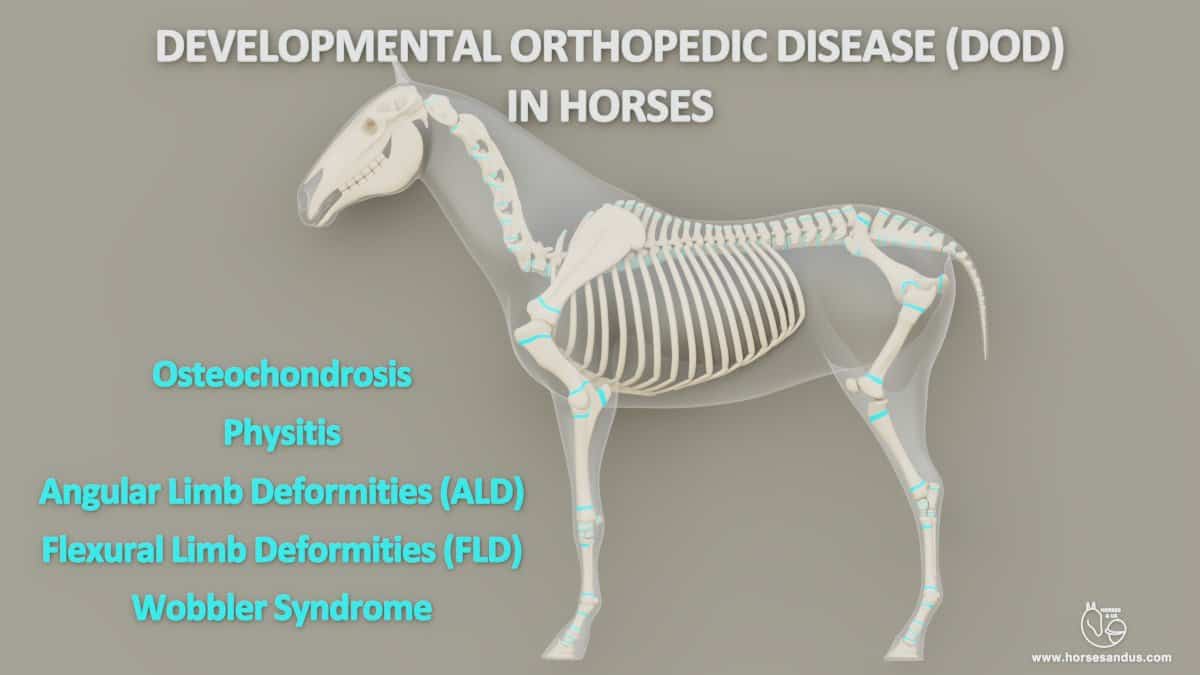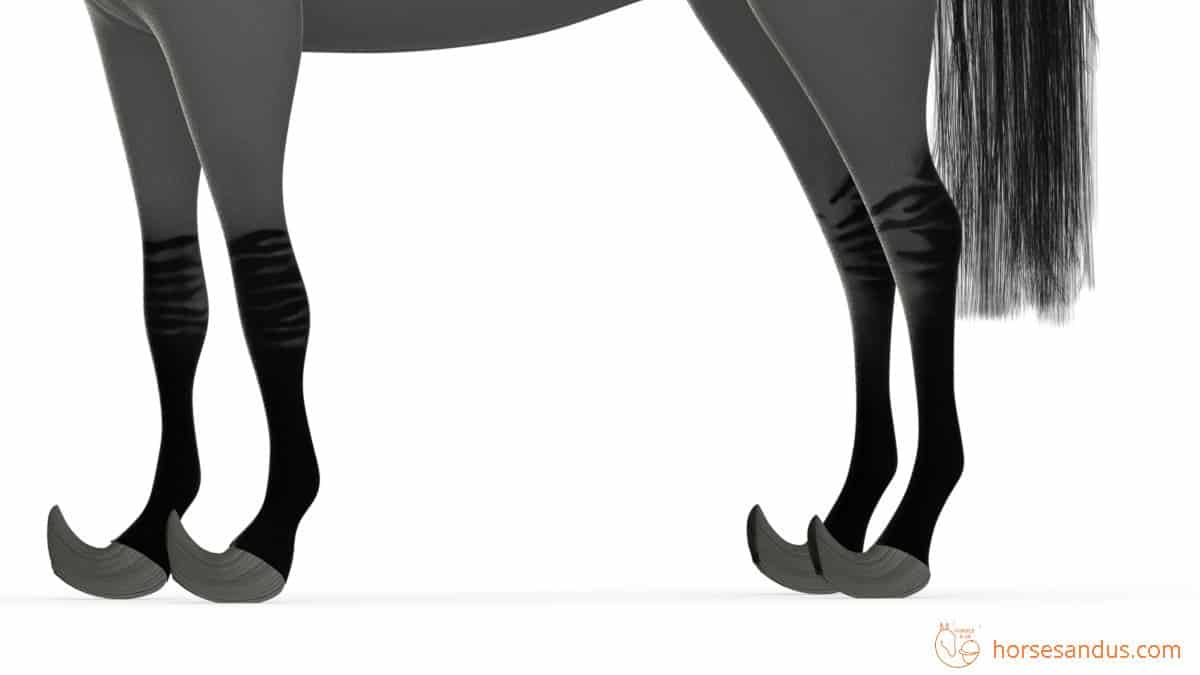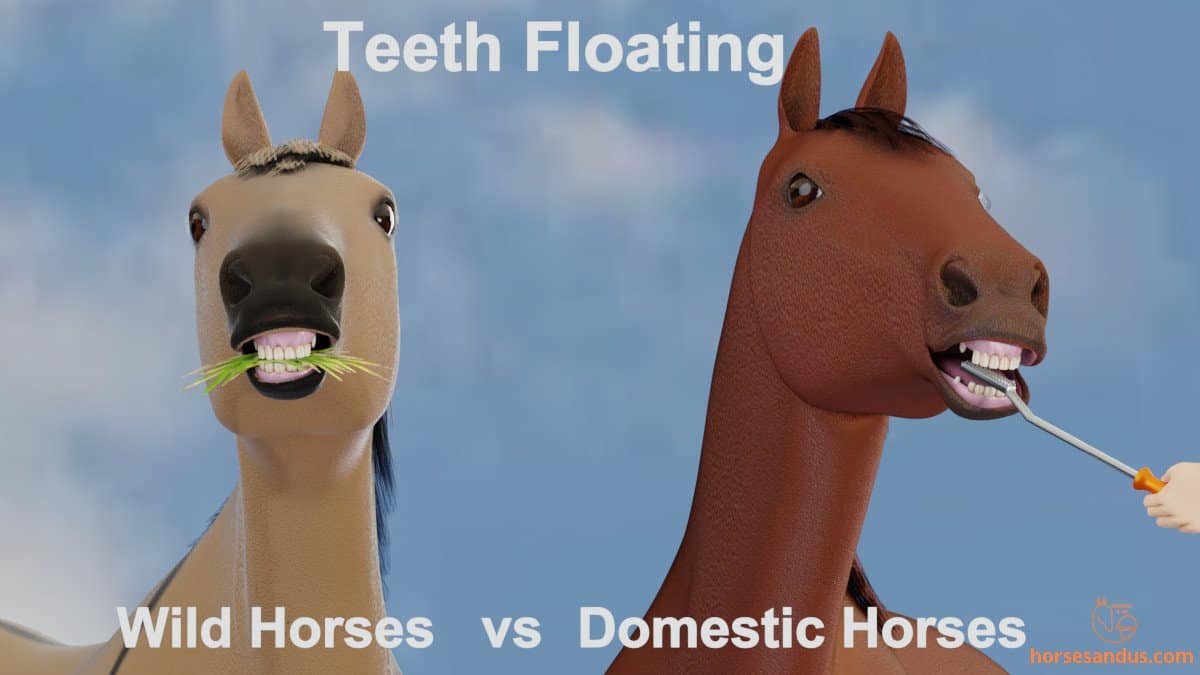Horses come in many different sizes and shapes and to accommodate this, blankets also come in many different sizes and styles.
Thus it is important that you know how to measure a horse for a blanket, so that you can select the right size for your horse.
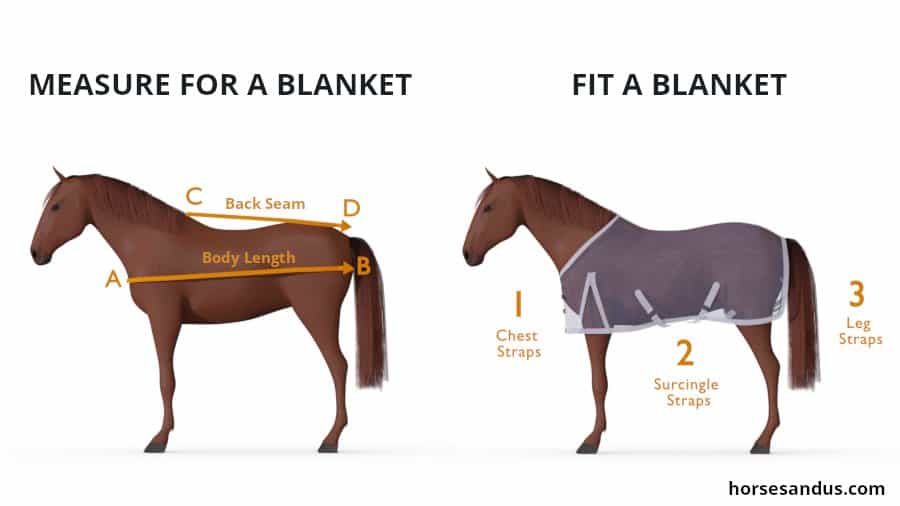
There are two methods to measure a horse for a blanket:
- Body Length: from the center of the chest to the point of buttocks .
- Back Seam: from the withers to the top of tail .
So you should use the method that is used by the manufacturer of the blanket you want to buy.
After buying the blanket you need to know how to put it on your horse.
To fit the horse blanket you need to adjust the straps in the following order:
- The chest straps located at the front of the blanket
- The surcingle straps that go under the horse’s belly
- The leg straps located in the back of the blanket
The straps should be adjusted so that the blanket fits your horse properly. Not too loose that it will slip and not too tight that it will pull.
Next, we will explain exactly how to measure a horse for a blanket and correctly put the blanket on your horse.
How to Measure a Horse For a Blanket
The horse blanket needs to be the correct size, so that the horse can be comfortable and safe:
If the blanket is too small:
- The blanket will rub your horse´s coat. The telltale is when hairs seem to be shortened. Often this occurs over the hips, on the shoulders around the neck, and on the withers. The skin will also become more tender in these areas and, in some cases, can even cause sores.
- The horse will not be able to move freely without being hindered by the blanket.
If the blanket is too large:
- It will not be snug and thus will let inside the winter elements: wind, snow, and rain and also the summer elements: insects and UV sun rays.
To ensure that you buy the right sized blanket that fits properly, you need to measure your horse.
There are two methods to measure the horse for blanketing. Measure the body length or measure the back seam.
1 – Measure the Body Length
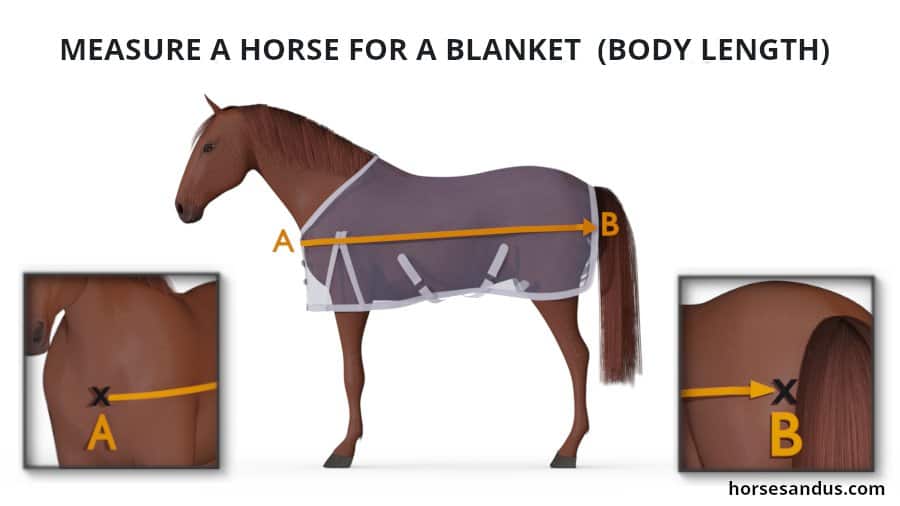
This method is used in the US, UK, and Australia. The measurement unit varies by country: US (inches), UK (feet), and Australia (cm).
Steps to Measure the Body length
- Start with the measuring tape in the center of the horse’s chest (just below the spot where the neck joins the body)
- Wrap the tape around the side of his body, crossing over the point of the shoulder (the widest part of the side). Make sure you keep the tape stretched.
- End with the measuring tape at the point of buttocks, which is where you want the blanket to end.
2 – Measure the Back Seam
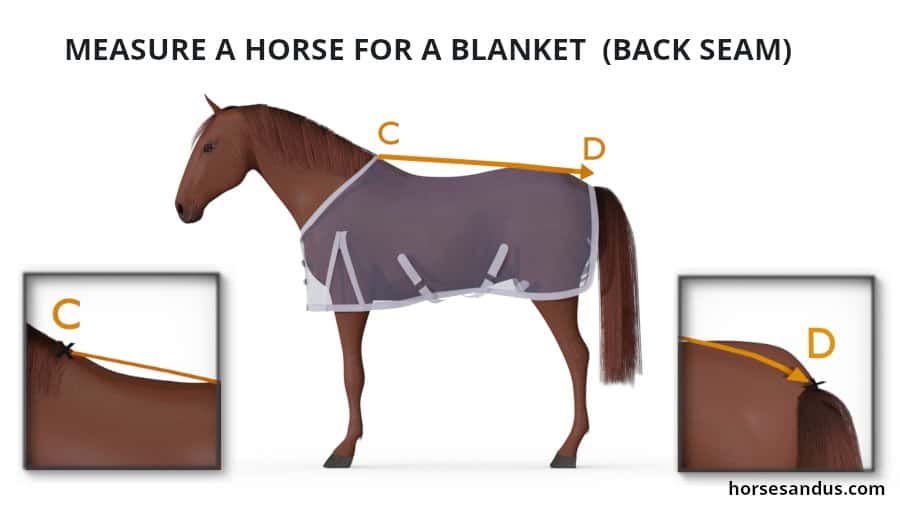
This method is used in the Europe and New Zealand. The measurement unit is cm.
Steps to Measure the Back Seam
- Start with the measuring tape at the tip of the withers
- End with the measuring tape at the top of the tail
Blanket Size Chart
After taking your horse’s measurements, search for the corresponding values on the manufacturer’s blanket size chart. This will give you the size you need to buy.
If there is not an exact match, then you should select the next biggest size in the chart.
Each manufacturer will provide a size chart. Below is an example of what it may look like:
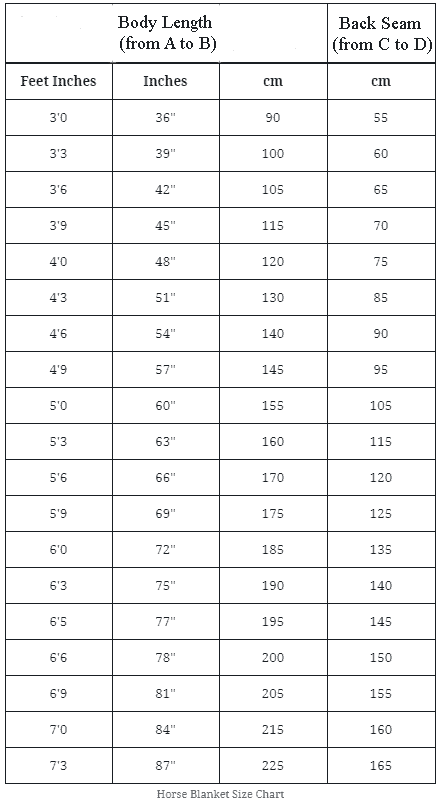
How Fit a Blanket On a Horse
After you have bought the blanket, you need to know how to fit it on your horse. Fitting the blanket properly is important for the comfort and protection of your horse.
You can see if the blanket has a good fit. If it is not too tight or too loose in any area of his body.
If you took the right measurements, the blanket should be the right length, i.e., it will cover the horse from just above his withers to just over his tail.
You can fit the blanket to the horse by adjusting the different straps in the blanket, starting at the front and ending at the rear.
The blanket should be draped over your horse without being too baggy (slipping and sliding over the horse’s body ) and without pulling on any spot (which can cause discomfort or rubbing).
5 Steps To Put On a Horse’s Blanket
There 5 steps to place a blanket on your horse.
1 – Lay the blanket over your horse’s body
If it is the first time he wears a blanket, be careful not to frighten him and ask someone to help you. Also, first, show the blanket to your horse before putting it over his body.
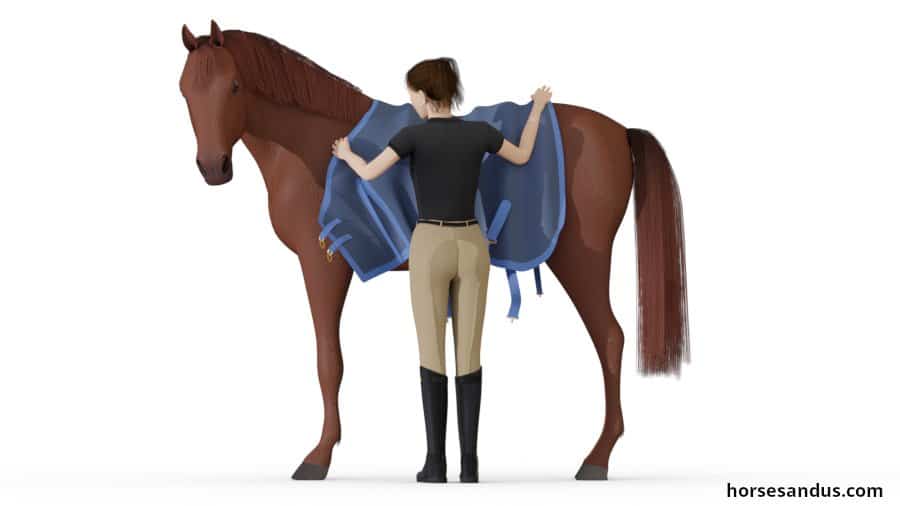
2 – Slide the blanket along the horse’s back until the top of the tail
The blanket’s back seam should lie at the top of the tail (at the tail dock).

3 – Adjust and fasten the chest straps
The blanket should overlap at the chest. Make sure the blanket fits well on the withers and shoulders.
- If it is too tight, it can cause rubbing and impede the horse from moving his neck freely.
- If it is too loose, it can slide around, and the wind and rain can get under the blanket.
Tip: Leave it so that you can fit your hand and be able to slide it down the neck of the blanket.
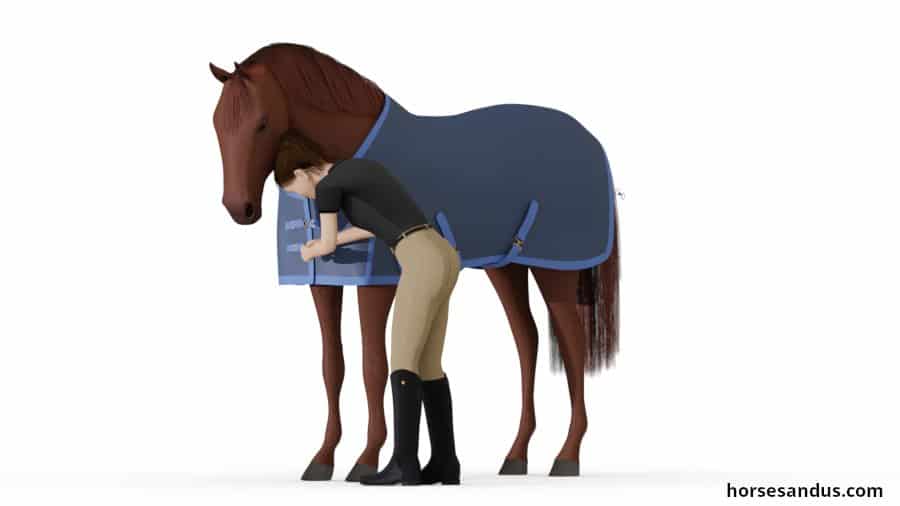
4 – Adjust the surcingle straps that go under the horse’s belly
These straps usually cross underneath the belly and hook on the opposite side of the blanket, making an X ( note that some blankets have belly straps that don’t cross). These straps should be adjusted to fit around the horse’s belly.
- They should not be too tight so that they cause rubbing and may tear the fabric.
- They should also not be too loose so that your horse can get his legs caught in them while lying down, rolling, and kicking forward.
Tip: Check that you can fit four fingers between the horse’s belly and the straps.
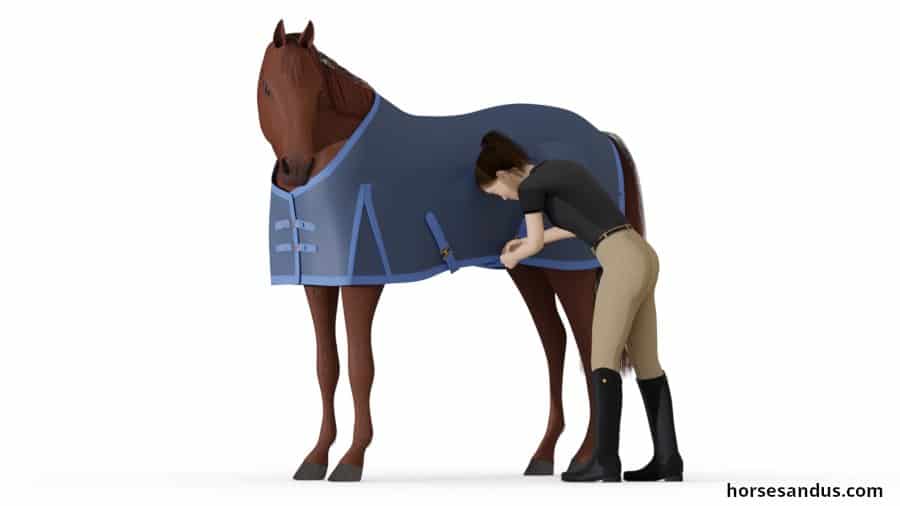
5 – Adjust the leg straps that are located at the back of the blanket.
These straps wrap around the back legs to prevent the blanket from sliding from the horse’s rear end and from flipping up on windy days.
Pick up the strap on the blanket’s left side, pass it inside the horse’s hind leg, and attach it to the buckle on the left side behind.
Next, pick the strap on the right side of the blanket, pass it inside the horse’s legs looping it with the other strap, and buckle it on the right side behind.
- You should not adjust the straps too tightly, so they inhibit movement or rub on the gaskin or groin’s tender areas.
- They should also not be too loose so that the horse’s legs can get caught in them.
Tip: Leave a hand’s width between the straps and the horse.
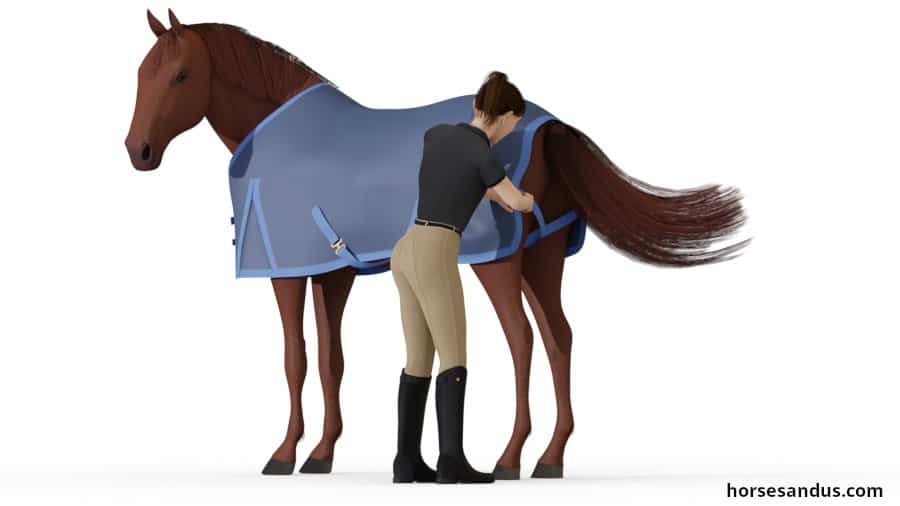
Finally, don´t forget to remove the blanket regularly (ideally every day) to check for any rubs or sores and assess the horse’s body condition.
The blanket is removed in the reverse order, i.e, starting at the rear and ending at the front.
Check this video which shows how to put on a horse´s blanket
Select a Blanket Style Based on Your Horse’s Conformation
There are some conformation points on your horse that need special attention when selecting the best cut or style of the blanket.
High Withers
On horses with high withers, the blankets will usually cause rubbing and sores at the withers. For these horses, you should try to find a blanket style specific for high withered horses:
- Blankets with a high neck design to lift the blanket off the withers.
- Foam padding at the withers to reduce pressure in this area.
- Cut back blankets that have a notch cut back around the withers so that these are left uncovered.
Large Chest
A Horse with a large chest usually gets rubbed on the shoulders and does not have a free range of movements with regular blankets. For these horses, you should buy a specific blanket:
- Blankets with adjustment straps on the neck opening, so you can enlarge the opening to avoid shoulder rubbing. This is also useful for horses with sloped shoulders.
- With an extra high gusset at the shoulder (an extra piece of fabric sewn into the blanket) that provides additional freedom of movement.
- You can also apply a chest extender providing extra room for the broader chests.
Large Hindquarters
A horse with large hindquarters usually gets rubbed on the hips and does not have a free range of movements with regular blankets. For these horses, you should look for:
- blankets that have gussets at the hind legs to allow for a greater range of motion.
